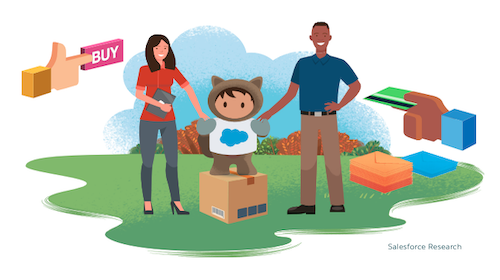When it comes to those who stand on the edge and, Kurt Vonnegut once famously said, you see “big, undreamed-of things” there. Marketers are the lookouts. Always scanning the horizon for emerging ideas, new technologies, and blueprints for better ways of living.
There’s no question that marketers are agents of change. And in an age when every industry around the globe is being disrupted, everyone is experiencing new ways of doing business. Marketers have their hands full with figuring out where the customer is going next and how they can be there to greet them.
We’re living in a world that’s being re-imagined by the Internet of Things. Re-ordered by AI. Re-shaped by COVID-19. No one’s sure what the future holds, but one thing is certain: sharing information will help make it a better place.
The sixth edition of the State of Marketing report presents insights from nearly 7,000 global marketing leaders across the globe. It highlights the priorities, challenges, and technologies that are shaping the current landscape. Marketers also reveal how innovative technologies will affect and transform the future. Developing an informed and flexible business strategy has never been more important. Especially as businesses shift their focus from crisis management and getting back to work to long-term growth.
Here are some of the report’s biggest takeaways from 300 marketers in Poland.
Innovation is the top priority for marketers in Poland
The customer journey can no longer be anything less than outstanding. In fact, 84% of customers say that the experiences companies provide are just as important as their products and services.
Today’s customers expect businesses to meet them whenever and wherever they please. In response, marketers are focussing on real-time engagement across a range of touchpoints. According to our State of the Connected Customer report, 71% of customers utilise several channels to start and complete transactions. Consumers have come to expect dynamic interactions. Meaning, creating tailored content on one channel for them in response to their actions on another channel. In Poland, only 53% of marketers describe their cross-channel content as being dynamic. So for many companies, there’s still a lot of work to be done.
Poland. Reportedly, 52% of respondents state that traditional marketing roles limit customer engagement. The report also shows a stark disconnect between marketing and IT departments. An astounding 91% of marketers in Poland see themselves as being aligned with their IT organisations. However, a separate study of IT leaders reveals that one of their biggest challenges is insufficient alignment between business units.
Digital transformation was a top priority even in the pre-pandemic world. But in the new climate, it’s nothing less than an imperative.
AI isn’t just the future; it’s here right now
The possibilities of artificial intelligence have inspired people for decades. Yet, AI is no longer a pie-in-the-sky future proposition; it’s the here and now. In fact, 74% of marketers in Poland – and 84% worldwide – have used AI. But this comes as no surprise. Today’s marketers focus on crafting memorable customer journeys and empathetic communications. They strive to create personalised experiences on individual channels. This is the top use for AI. However, the fact that 89% of marketers now describe their customer engagement as being data-driven is revelatory.
Indeed, marketers are now using an average of nine different customer data sources! The top three being customer preferences and interests, known digital identities, and transactional data.
The takeaway here is that digitalisation is no longer just a competitive advantage for forward-thinking innovators. It’s the norm and companies that haven’t adopted digital solutions will struggle to keep up with their customers’ expectations.
Account-based marketing (ABM) is driving B2B engagement
Nowadays, B2B customers expect the same level of engagement as their B2C counterparts. Luckily for B2B marketers, account-based marketing (ABM) programs can help build meaningful engagement by using data and AI to construct highly personal campaigns. ABM tools help marketers connect in real-time. They also increase the lifetime value of their customer relationships.
The popularity of ABM programs is rising all the time – 64% were started within the last five years. Moreover, 92% of the world’s B2B marketers now use an ABM program. Even in the limited time that they’ve been in use, these programs have grown increasingly advanced. In fact, 68% of them now utilise automation.
New technologies are key to navigating an uncertain future
The world is changing rapidly and no one knows for sure what’s coming over the horizon. The COVID-19 pandemic has led to unprecedented ways of doing business, along with new and more personal ways of engaging the customer. Ideas that we’ve been talking about for years have now been put into practice and the acceleration of innovative thought is remarkable to watch.
So what might the next ten years bring? Marketers expect to see more of the global population getting online and virtual reality becoming mainstream. This may lead to everything from job training simulators and travel experiences to virtual empathy machines that let you walk in another person’s shoes. In Poland, 64% of marketing leaders think that 5G will have a major impact on marketing in the decade ahead. Faster speeds will lead to chains of new ideas and better connections, between both devices and humans.
As marketers continue to lead through change, a combination of emerging tech and innovative strategies will ensure success in the ‘Next Normal’ and beyond. Read the full report to learn the top priorities and challenges for nearly 7,000 marketing leaders around the world!




